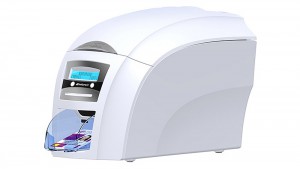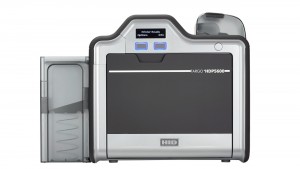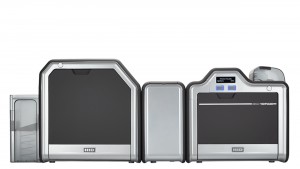ID Card Printing
ID Card Printing

ID Card Printing
 AlphaCard.com
AlphaCard.com
ID Card Printing
There are three principal digital card printing technologies used by desktop systems to print personalized cards: dye-sublimination printing, reverse-image printing, and inkjet printing.
Dye-sublimation printing is the most common technology used by digital card printers to print images directly onto the surface of a plastic ID card. The process involves heating a special print ribbon beneath a thermal printhead and applying pressure so that the ribbon is in contact with the card and the printhead rests on the top of the ribbon, resulting in the transfer of color from the ribbon to a blank ID card.
Reverse image printing is a process in which the printer first prints images onto a special film, which is then laminated onto the surface of a blank card through heat and pressure. By printing on the film rather than directly on the surface of a card, the ceramic printheads in high definition printing systems are less susceptible to damage that can result from contact with debris or imperfections on the hard surface of a card. High definition printing also eliminates many of the printing irregularities that can occur in direct-to-card printing when the printhead fails to maintain contact with a dirty or uneven card surface. Proximity cards and smart cards, which tend to have uneven surfaces due to embedded wires and smart chips, have more successful printing results using high definition printing. High definition printing generally produces higher quality images than direct-to-card printing, and affords users the ability to print on many ID card sizes, types, or chemical compositions, including biodegradable cards.
Inkjet printing systems are the standard printing technology for desktop computing due to their ease of use and quiet and reliable operation. However, this form of non-impact printing has only recently been introduced in the photo ID card market, because the inks are water-based and do not readily adhere to plastic cards. However inkjet technology and card materials continue to improve and manufacturers such as Fargo Electronics have released some very easy-to-use, reliable and high-quality inkjet ID card printers.
-

Fargo DTC1000 Single Sided
MSRP: $2,299Price: $1,450You Save: $849 (37%)
- Dye Sublimation
- Hopper: 100 In / 100 Out
- Warranty: 2
-

Fargo HDP5000 Printer - Single-Sided
MSRP: $5,745Price: $3,278.99You Save: $2,466.01 (43%)
- Reverse Transfer
- Hopper: 100 In / 200 Out
- Print Speed: 29 Seconds
- Warranty: 3 Years
-

Magicard Enduro3E ID Card Printer
MSRP: $2,295- Dye Sublimation & Rewritable
- Hopper: 100 In / 30 Out
- Print Speed: 35 Seconds
- Warranty: 3 Years
-

Fargo HDP5600 Reverse Transfer ID Card Printer
MSRP: $3,995Add to Cart or Click for Best Price- Reverse Transfer
- Hopper: 100 In / 200 Out
- Print Speed: 24 Seconds
- Warranty: 3 Years
-

Fargo HDP5600 Reverse Transfer ID Card Printer with Lamination
MSRP: $6,495Add to Cart or Click for Best Price- Reverse Transfer
- Hopper: 100 In / 200 Out
- Print Speed: 24 Seconds
- Warranty: 3 Years
-

Fargo DTC5500LMX Laminating ID Card Printer
MSRP: $7,499Add to Cart or Click for Best Price- Dye Sublimation
- Hopper: 200 In / 100 Out
- Print Speed: 16 seconds
- Warranty: 3 Years
Not sure how to choose
an ID card printer?


The Complete Card
Printer Buyer's Guide
With such a wide range of ID printers, evaluating the options can be overwhelming. This FREE 7-step guide will walk you through choosing the perfect card printer.
GET YOUR FREE GUIDE

